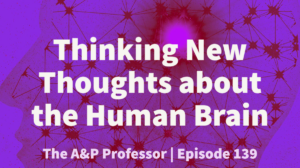In Episode 139, we explore a new discovery in nerve signaling in the brain called a dendritic action potential (dCaAP), we look at a whacky proposed model of brain function, and we share some ideas about how we can help our students understand the core concepts of chemical signaling and signal transduction in different contexts. Put on your thinking caps and jump into this fresh episode now.
00:00 | Introduction
00:50 | Dendritic Action Potentials
12:16 | Transducer Model of the Brain
21:43 | Chemical Signals & Signal Transduction
35:09 | Staying Connected
★ If you cannot see or activate the audio player, go to: theAPprofessor.org/podcast-episode-139.html
🏅 Apply for your credential (badge/certificate) for listening to this episode: theAPprofessor.org/podcast-episode-139.html/#badge
⭐⭐⭐⭐ Please rate & review this podcast so that others can decide whether to give it a try: RateThisPodcast.com/theAPprofessor
❓ Please take the anonymous survey: theAPprofessor.org/survey
☝️ Questions & Feedback: 1-833-LION-DEN (1-833-546-6336)
✔️ Follow The A&P Professor on Twitter, Facebook, Blogger, Revue, Tumblr, or Instagram! @theAPprofessor
📰 Get the once-or-twice-weekly TAPP Science & Education Updates theAPprofessor.org/updates
The adage that fact is stranger than fiction seems to be especially true for the workings of the brain. (V.S. Ramachandran)
Dendritic Action Potentials
11.5 minutes
In this segment, the focus is on a fascinating discovery about nerve signaling related to dendritic action potentials (dCaAPs). These unique potentials occur in layers two and three of the human cerebral cortex and play a role in complex brain functions. Unlike typical action potentials, dendritic action potentials are graded and produced by the influx of calcium ions. They enable processing and decision-making at a more complex level, expanding our understanding of the human brain's uniqueness.
★ Scientists Uncover a Never-Before-Seen Type of Signal Occurring in The Human Brain (plain English summary of the new discovery from Science Alert) AandP.info/p08
★ Dendritic action potentials and computation in human layer 2/3 cortical neurons (report in Science) AandP.info/g48
Please rate & review The A&P Professor—it helps others decide whether to give us a try! 😁
★ RateThisPodcast.com/theAPprofessor
Transducer Model of the Brain
9.5 minutes
Join us in this segment as we challenge conventional models of the brain and introduce the transducer model. Inspired by psychologist Robert Epstein, this thought-provoking model likens the brain to a two-way transducer, sending and retrieving information like a mobile phone accessing external servers. While it may sound far-fetched—even quite wacky—the transducer model encourages us to explore alternative perspectives and consider the possibility of information exchange beyond the confines of the brain.
★ Your Brain Is Not a Computer. It Is a Transducer. (essay by Robert Epstein about neural transduction theory in Discover Magazine) AandP.info/wa9
★ Brain as Transducer: What if the brain is not a self-contained information processor? What if it is simply a transducer? (another essay by Robert Epstein in the transducer model) AandP.info/cp6
★ Brain Waves Synchronize when People Interact (article from Scientific American) AandP.info/ask
★ Should We Extend Deadlines? | Models & Color Codes | TAPP 112
Chemical Signals & Signal Transduction
13.5 minutes
Chemical signaling and signal transduction play a crucial role in various systems of the human body. Understanding the connections and similarities between nervous and endocrine signaling helps students grasp these core concepts more deeply. By highlighting structures, functional aspects, and regulatory effects, instructors can foster a comprehensive understanding of chemical signals and the transduction of those signals. Exploring these core concepts within a broader context enhances students' ability to connect and apply their knowledge across different topics. Kevin gives examples of how he approaches this in his courses.
★ Big Ideas: The Essential Concepts of A&P | Episode 35
★ Deep Elaboration & Other Stories of Teaching Anatomy & Physiology | TAPP 136
★ Concept Lists Help Students Build Conceptual Frameworks
★ Star Power Helps Students Identify Learning Goals | TAPP 98
★ Concept Maps Help Students Find Their Way | Episode 5
People
Production: Aileen Park (announcer), Andrés Rodriguez (theme composer, recording artist), Rev.com team (transcription), Karen Turner (Executive Editor), Kevin Patton (writer, editor, producer, host).
Not People
Robotic (AI) audio processing is done by Auphonic.com and the content, spelling, grammar, style, etc., of these episode notes are assisted by various bots.
If the hyperlinks here are not active, go to TAPPradio.org to find the episode page.
★ More details at the episode page: theAPprofessor.org/podcast-episode-139.html
★ Transcript available in the transcript box: theAPprofessor.org/podcast-episode-139.html
★ Need help accessing resources locked behind a paywall? Check out this advice from Episode 32 to get what you need! my-ap.us/paywall
Take The A&P Professor experience to the next level!
★ theAPprofessor.org/community
Earn cash by referring other A&P faculty to this podcast:
Tools & Resources
★ TAPP Science & Education Updates: theAPprofessor.org/updates
★ Amazon: amzn.to/2r6Qa3J
★ Text Expander: theapprofessor.org/textexpander
★ Rev.com (transcription): try.rev.com/Cw2nZ
★ Auphonic (audio processing): AandP.info/auphonic
★ Snagit & Camtasia: techsmith.pxf.io/9MkPW
★ JotForm (build forms for free): theAPprofessor.org/jotform
★ Mobile Pixels (laptop monitor extender): thttps://aandp.info/XtraMonitor
★ QuillBot (writing tools): theAPprofessor.org/quillbot
★ The A&P Professor Logo Items: https://www.teepublic.com/stores/the-a-p-professor
Follow The A&P Professor on Twitter, Facebook, Mastodon, Reddit, TikTok,LinkedIn, Blogger, Revue, Tumblr, or Instagram @theAPprofessor
The A&P Professor® and Lion Den® are registered trademarks of Lion Den Inc. (Kevin Patton)
As an Amazon Associate I earn from qualifying purchases. I may be compensated for links to sponsors and certain other links.
Click here to listen to this episode—or access the detailed notes and transcript.


No comments:
Post a Comment